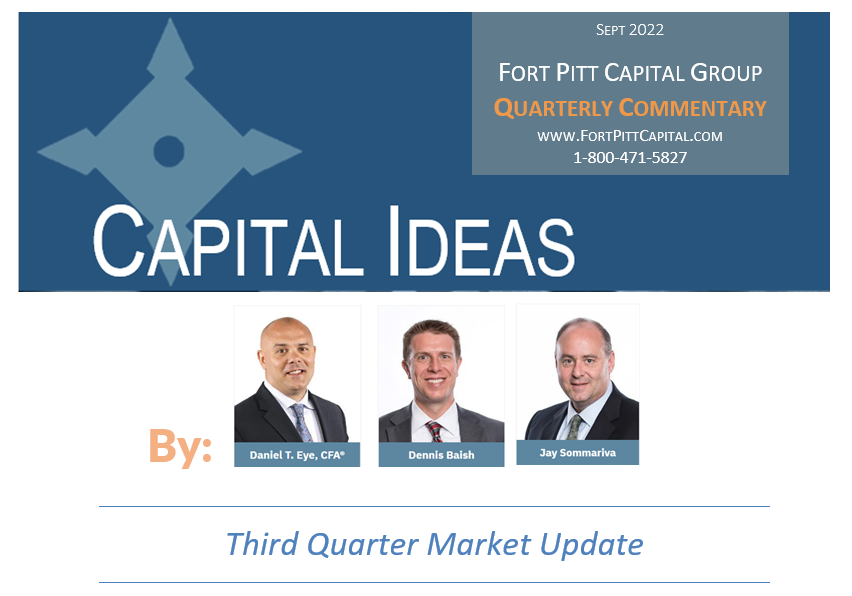Third Quarter Market Update

Equity markets rallied from mid-June through mid-August, with the S&P 500 Index advancing by almost 18% over that two-month stretch. This bounce was primarily attributable to the narrative that the Federal Reserve would pause or pivot away from their aggressive interest rate hiking campaign. However, Fed Chairman Jerome Powell torched the idea of a policy pivot with his Jackson Hole speech in late August. Instead, Powell reiterated the Fed’s commitment to taming inflation and showed little concern for the resulting “pain” for households and businesses. The short speech could have been condensed further by Powell simply stating that aggressive interest rate hikes will continue, and they firmly recognize that they are going to have to put some people out of work to curb demand.
The Fed cemented their hawkish stance last week with their third consecutive outsized, 75 basis point increase which sets the new Federal Funds range at 3.00% to 3.25%. The median projections for the Federal Funds rate also increased significantly to 4.4% by the end of the year before peaking out at 4.6% sometime in 2023. Markets have reacted swiftly to tighter monetary policy projections, with short-term government bond yields spiking to 15-year highs and equity markets cascading back down to the mid-June lows.
We still view inflation as the linchpin for near-term outcomes. The Fed can’t pivot away from their hiking path with inflation still at 40-year highs, and they also need to manage future inflation expectations to ensure price pressures do not become ingrained in our economy. While progress on the inflation front has been disappointingly slow, we are seeing some encouraging signs of relief as well as some early trends that we anticipate continuing. An abbreviated list of these data points is listed below.
- Oil prices dropped below $80/ barrel last week. This represents a 35% decline from the March peak and oil prices are now lower than before Russia invaded Ukraine. This is translating into measurable declines in gasoline prices, a broad decline in shipping/transportation costs, and a 14% drop in airline fares compared to the May peak. (From J.P. Morgan Markets report published on 09/20/22 under the title of “Under the Hood”)
- Used car prices have declined by 13% from the January peak. (Based on price comparisons from the Manheim Used Vehicle Value Index)
- We expect new car prices to start rolling over as supply chains continue to improve and semiconductor capacity is freed up due to reduced demand for PCs and smartphones.
- In addition to these indicators, we have also been encouraged that longer-term (3-5 year) inflation expectations have not only remained well-anchored but have declined since the first quarter of the year. Market-based measures, consumer surveys, and professional forecasters all anticipate that the Fed is the ultimate winner in the inflation battle.
There has been less observable progress within services inflation. And that’s a problem since services account for more than 70% of core inflation. Rental inflation is the big problem here, with rents representing approximately 40% of the overall inflation basket. It’s no surprise rental prices have skyrocketed given the massive appreciation in real estate assets driven by the long stretch of ultra-low interest rates and unprecedented government stimulus. Historically, rents have followed housing prices with about a 12-month lag. This explains the Fed’s recent comments about the need for a correction in the housing market. We are seeing the early stages of a rollover in the housing market and indications that this is starting to translate into easing rental prices. An abbreviated list of these data points is listed below.
- 30-year mortgage rates at close to 7% are translating into a stunning decline in affordability and discouraging home buying.
- In July, the CoreLogic HPI (Home Price Index) showed the largest month-over-month decline in home prices in 10 years.
- Homebuilders are having trouble selling the houses that they have already built or are building, sales have plunged, and inventories have spiked to the highest since 2008. Homebuilders have started cutting prices, buying down mortgage rates, and piling on other incentives to get their inventory moving.
- The asking rents on new leases peaked at 17% year-over-year in February of this year, with year-over-year increases easing to 12% in August. This is still dramatically higher than the 4% average annual increase pre-pandemic but headed in the right direction.
We expect home prices to continue to moderate and start to translate into significantly lower rental inflation by Q1/Q2 of 2023. A significant drop in the component that represents 40% of the entire inflation calculation is what is desperately needed to move us back toward the Fed’s 2% inflation target.
We also believe we are entering the peak Fed hawkishness zone. Fixed income markets have already priced in about 90% of the Fed’s final destination within the tightening cycle. While their view on the final destination could change, we think at some point, the Fed is going to want to slow the pace of rate hikes and take some time to observe the lagged outcome of their policy decisions. We expect the impacts of higher interest rates to become more evident in the coming months and quarters. Housing weakness, rising unemployment, and lower consumer spending should result in stabilizing interest rates. While we don’t like rooting for bad economic data, we need interest rates to stabilize in order for equity markets to find their footing.
Stocks have gotten significantly cheaper as a result of this year’s market decline. The S&P 500 Index is trading at roughly 15 times 2023 earnings estimates. That’s pretty cheap compared to long-term historical averages and not too far from where markets bottomed in previous selloffs (December 2018 & March 2020). However, 2023 estimates are still calling for about 8% earnings growth. We feel these estimates are too optimistic given the wide range of potential economic outcomes, which are skewed to the downside given the Fed’s goal of softening the labor market and below-trend economic growth. However, market indices aren’t too far away from trading at reasonable valuations, even with a pessimistic assumption for earnings in 2023. That scenario comes into greater focus with another 5%-10% downside from current levels and could set up for a more durable market bottom.
A few parting words:
- As all previous market bottoms have taught us, markets are forward-looking and tend to bottom well before all the bad news, data, and headlines go away.
- We feel strongly that there are opportunities being created in this environment. Our conviction level is high that current market prices don’t adequately reflect the long-term earnings power of the businesses that we own.
- After every bear market is a bull market.


